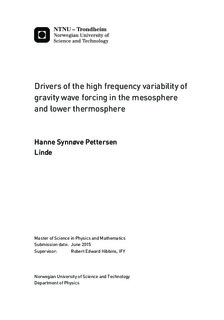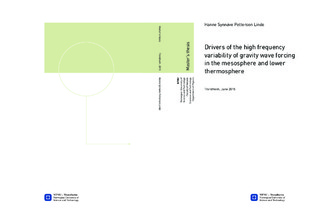| dc.description.abstract | In this thesis the influence of gravity waves (GWs) in the mesosphere/lower thermosphere (MLT) was analysed. This was inspired by the work done in the paper by de Wit et al. (2014), which used the SKiYMET meteor radar in Trondheim, Norway to study the seasonal cycle of the GW forcing (GWF) in the MLT, in 2013. The results agreed well with previous research, but a high temporal frequency variability in the GWF was also observed that could not be explained any further. The intention for this thesis was therefore to investigate possible mechanisms that could cause this variability. This was done by studying the atmosphere below the MLT on a daily basis, with the focus on GW generation and activity. Information about the wind speed in the atmosphere, which was used to measure the GWs, was obtained by meteorological reanalysis.
The three mechanisms studied were the GW generation in the troposphere, described by the tropospheric winds, secondly, the GW activity in the lower stratosphere, which was derived from the kinetic energy of the GWs and thirdly, the GW filtering which measured the atmospheric transmission of GWs from the ground to the MLT. Finally, the variability in each part was compared to the variability in the GWF. The results revealed correlation coefficients that varied between -0.2958 to 0.6932, significantly correlated above the 99% confidence level. Investigations were undertaken to determine if these correlations were due primarily to the seasonal cycle of the GWF. When the seasonal effects were removed through filtering, all of the correlation coefficients dropped and became insignificant. Hence, neither of these mechanisms could explain the high frequency variability in the GWF in more detail. On the other hand, it was found that by applying a restriction on the phase speed of the GWs that propagated through the GW filter, slightly improved the correlation with the GWF on a seasonal basis. Compared to no restriction, it went from explaining 42% to 48% of the variance in the GWF. This was an interesting result which could be investigated further to see if it could be implemented in weather and climate models to take account for the GW effect more accurately. | |

